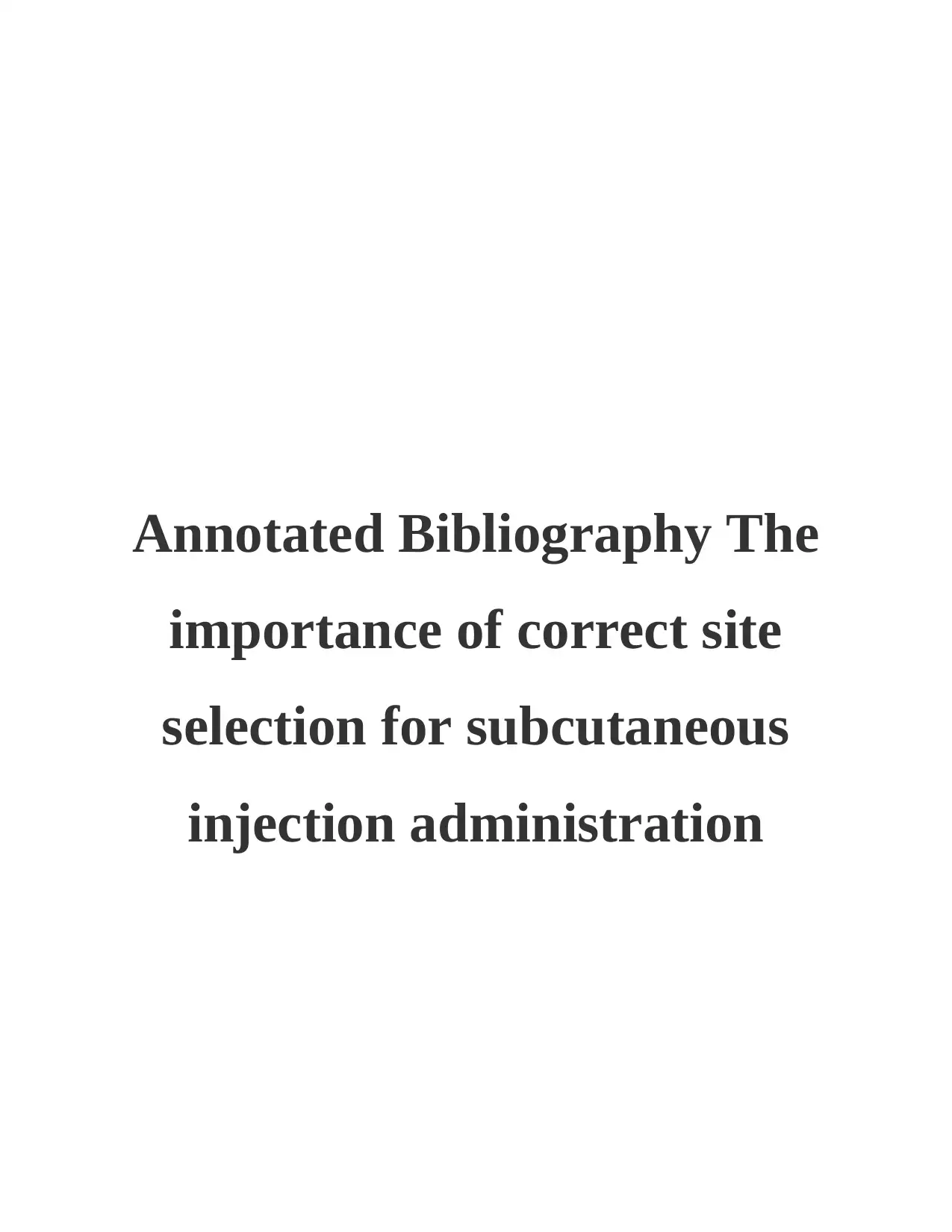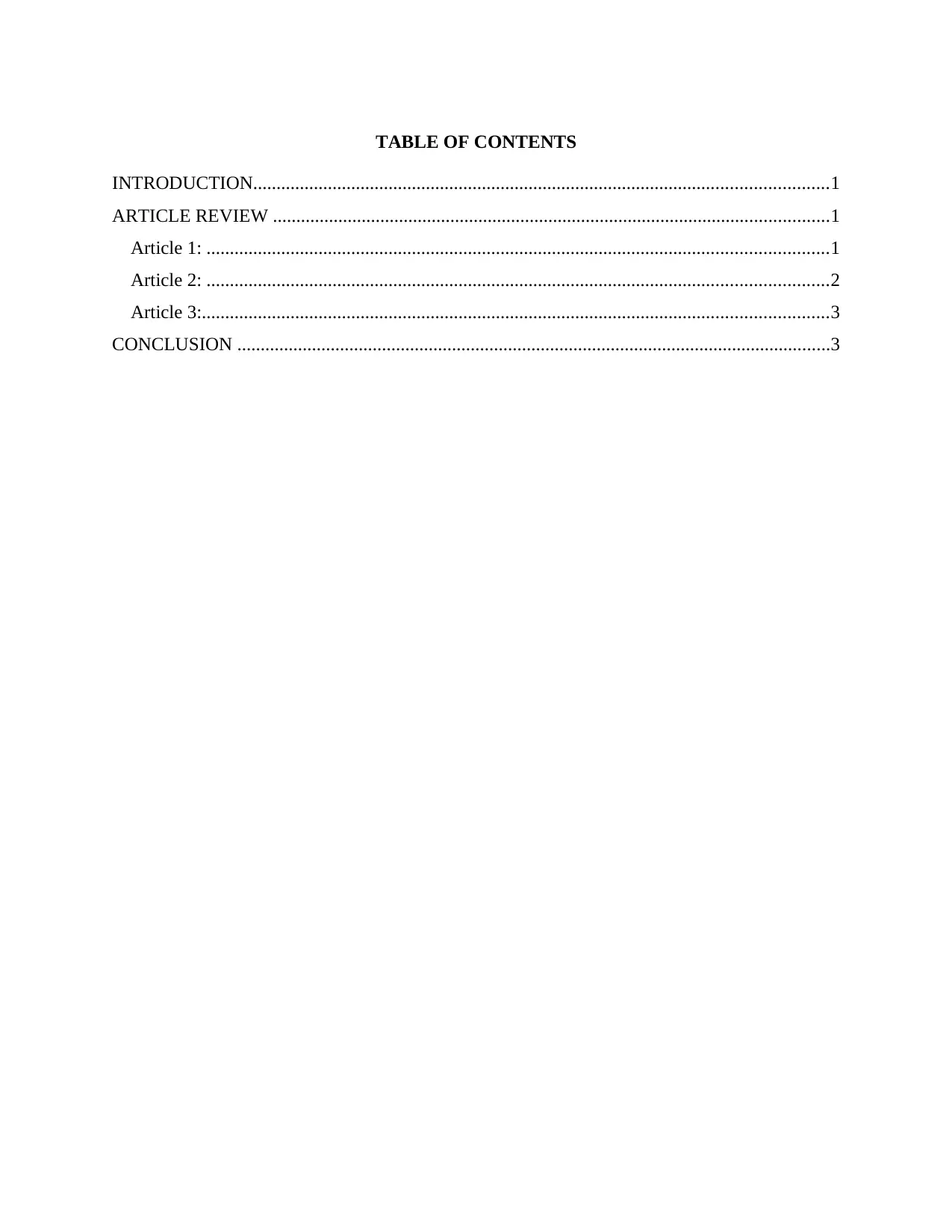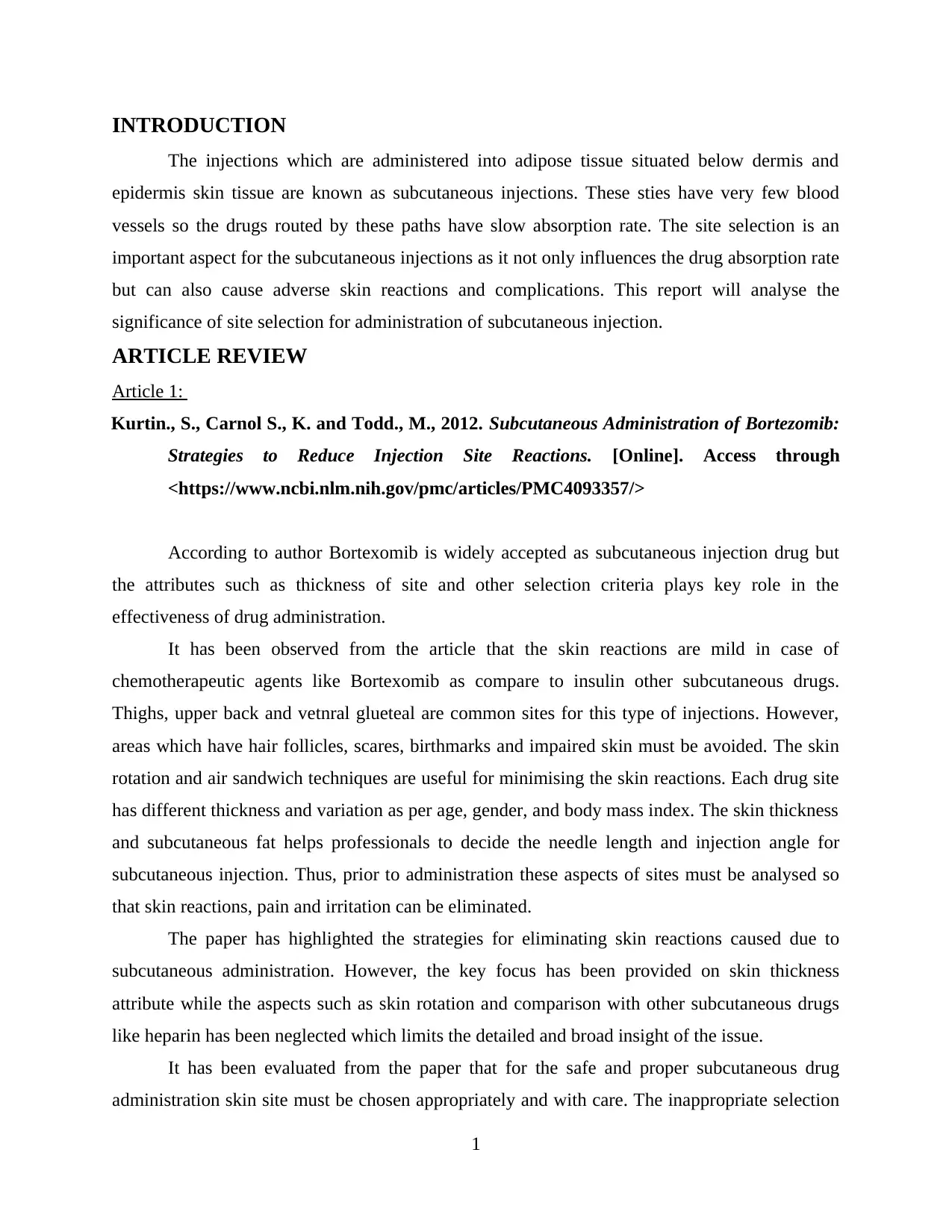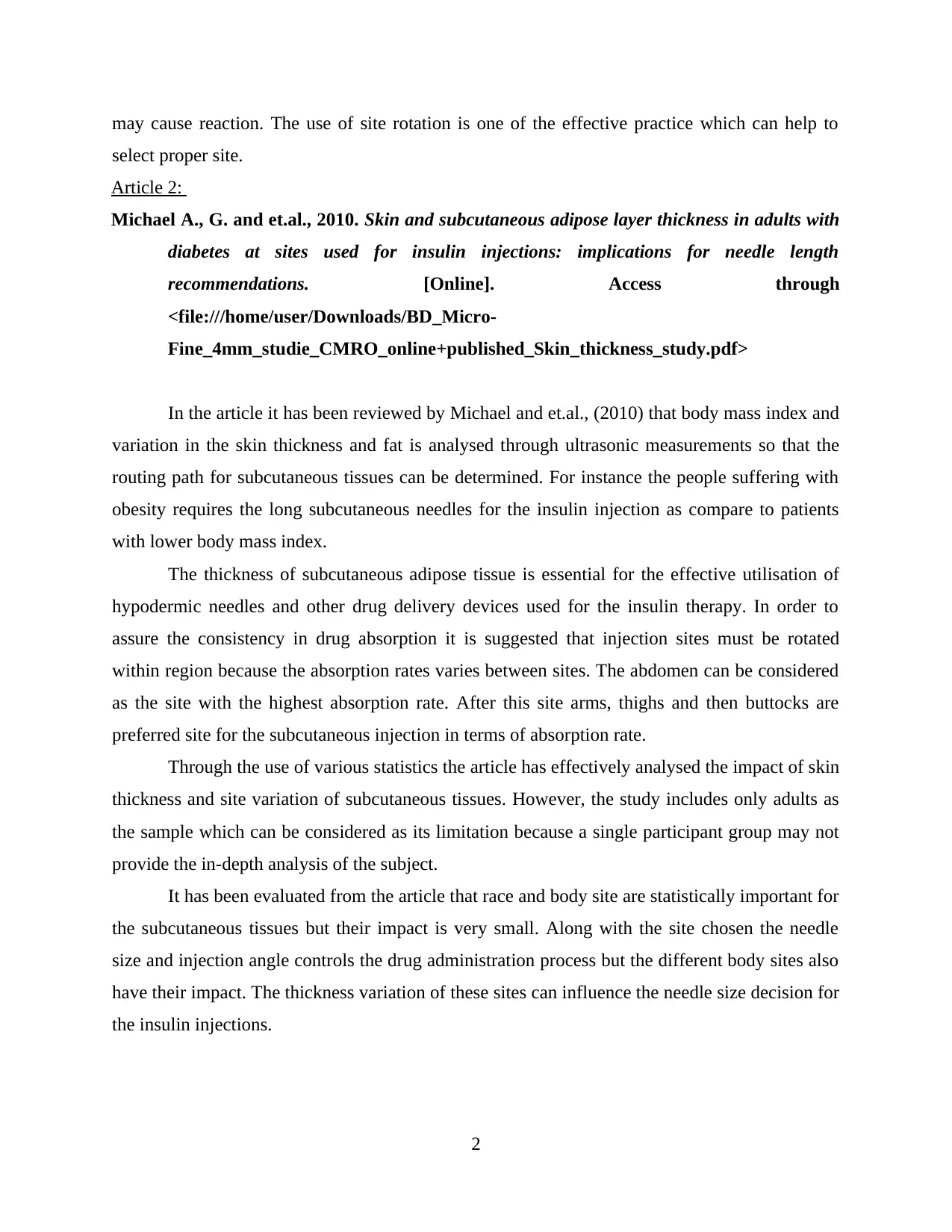Annotated Bibliography: Subcutaneous Injection Site Selection
VerifiedAdded on 2020/12/09
|10
|1157
|96
Annotated Bibliography
AI Summary
This annotated bibliography examines the critical importance of proper site selection for subcutaneous injections. It reviews three articles focusing on the impact of site selection on drug absorption rates, skin reactions, and overall patient outcomes. The first article highlights strategies for minimizing skin reactions, particularly with drugs like Bortezomib, emphasizing the significance of skin thickness and the use of techniques like skin rotation. The second article, focusing on adults with diabetes, analyzes the relationship between skin thickness, body mass index, and the need for varying needle lengths, underscoring the importance of site rotation for consistent absorption. The third article emphasizes the potential harm of repeated injections at the same site, discussing the need for proper site selection and the importance of nurses' understanding to minimize complications such as bruising, swelling, and pain. The bibliography concludes that appropriate site selection is crucial for effective and safe subcutaneous drug administration, highlighting the need for careful consideration of skin thickness, site rotation, and patient-specific factors.

Annotated Bibliography The
importance of correct site
selection for subcutaneous
injection administration
importance of correct site
selection for subcutaneous
injection administration
Paraphrase This Document
Need a fresh take? Get an instant paraphrase of this document with our AI Paraphraser

TABLE OF CONTENTS
INTRODUCTION...........................................................................................................................1
ARTICLE REVIEW .......................................................................................................................1
Article 1: .....................................................................................................................................1
Article 2: .....................................................................................................................................2
Article 3:......................................................................................................................................3
CONCLUSION ...............................................................................................................................3
INTRODUCTION...........................................................................................................................1
ARTICLE REVIEW .......................................................................................................................1
Article 1: .....................................................................................................................................1
Article 2: .....................................................................................................................................2
Article 3:......................................................................................................................................3
CONCLUSION ...............................................................................................................................3

INTRODUCTION
The injections which are administered into adipose tissue situated below dermis and
epidermis skin tissue are known as subcutaneous injections. These sties have very few blood
vessels so the drugs routed by these paths have slow absorption rate. The site selection is an
important aspect for the subcutaneous injections as it not only influences the drug absorption rate
but can also cause adverse skin reactions and complications. This report will analyse the
significance of site selection for administration of subcutaneous injection.
ARTICLE REVIEW
Article 1:
Kurtin., S., Carnol S., K. and Todd., M., 2012. Subcutaneous Administration of Bortezomib:
Strategies to Reduce Injection Site Reactions. [Online]. Access through
<https://www.ncbi.nlm.nih.gov/pmc/articles/PMC4093357/>
According to author Bortexomib is widely accepted as subcutaneous injection drug but
the attributes such as thickness of site and other selection criteria plays key role in the
effectiveness of drug administration.
It has been observed from the article that the skin reactions are mild in case of
chemotherapeutic agents like Bortexomib as compare to insulin other subcutaneous drugs.
Thighs, upper back and vetnral glueteal are common sites for this type of injections. However,
areas which have hair follicles, scares, birthmarks and impaired skin must be avoided. The skin
rotation and air sandwich techniques are useful for minimising the skin reactions. Each drug site
has different thickness and variation as per age, gender, and body mass index. The skin thickness
and subcutaneous fat helps professionals to decide the needle length and injection angle for
subcutaneous injection. Thus, prior to administration these aspects of sites must be analysed so
that skin reactions, pain and irritation can be eliminated.
The paper has highlighted the strategies for eliminating skin reactions caused due to
subcutaneous administration. However, the key focus has been provided on skin thickness
attribute while the aspects such as skin rotation and comparison with other subcutaneous drugs
like heparin has been neglected which limits the detailed and broad insight of the issue.
It has been evaluated from the paper that for the safe and proper subcutaneous drug
administration skin site must be chosen appropriately and with care. The inappropriate selection
1
The injections which are administered into adipose tissue situated below dermis and
epidermis skin tissue are known as subcutaneous injections. These sties have very few blood
vessels so the drugs routed by these paths have slow absorption rate. The site selection is an
important aspect for the subcutaneous injections as it not only influences the drug absorption rate
but can also cause adverse skin reactions and complications. This report will analyse the
significance of site selection for administration of subcutaneous injection.
ARTICLE REVIEW
Article 1:
Kurtin., S., Carnol S., K. and Todd., M., 2012. Subcutaneous Administration of Bortezomib:
Strategies to Reduce Injection Site Reactions. [Online]. Access through
<https://www.ncbi.nlm.nih.gov/pmc/articles/PMC4093357/>
According to author Bortexomib is widely accepted as subcutaneous injection drug but
the attributes such as thickness of site and other selection criteria plays key role in the
effectiveness of drug administration.
It has been observed from the article that the skin reactions are mild in case of
chemotherapeutic agents like Bortexomib as compare to insulin other subcutaneous drugs.
Thighs, upper back and vetnral glueteal are common sites for this type of injections. However,
areas which have hair follicles, scares, birthmarks and impaired skin must be avoided. The skin
rotation and air sandwich techniques are useful for minimising the skin reactions. Each drug site
has different thickness and variation as per age, gender, and body mass index. The skin thickness
and subcutaneous fat helps professionals to decide the needle length and injection angle for
subcutaneous injection. Thus, prior to administration these aspects of sites must be analysed so
that skin reactions, pain and irritation can be eliminated.
The paper has highlighted the strategies for eliminating skin reactions caused due to
subcutaneous administration. However, the key focus has been provided on skin thickness
attribute while the aspects such as skin rotation and comparison with other subcutaneous drugs
like heparin has been neglected which limits the detailed and broad insight of the issue.
It has been evaluated from the paper that for the safe and proper subcutaneous drug
administration skin site must be chosen appropriately and with care. The inappropriate selection
1
⊘ This is a preview!⊘
Do you want full access?
Subscribe today to unlock all pages.

Trusted by 1+ million students worldwide

may cause reaction. The use of site rotation is one of the effective practice which can help to
select proper site.
Article 2:
Michael A., G. and et.al., 2010. Skin and subcutaneous adipose layer thickness in adults with
diabetes at sites used for insulin injections: implications for needle length
recommendations. [Online]. Access through
<file:///home/user/Downloads/BD_Micro-
Fine_4mm_studie_CMRO_online+published_Skin_thickness_study.pdf>
In the article it has been reviewed by Michael and et.al., (2010) that body mass index and
variation in the skin thickness and fat is analysed through ultrasonic measurements so that the
routing path for subcutaneous tissues can be determined. For instance the people suffering with
obesity requires the long subcutaneous needles for the insulin injection as compare to patients
with lower body mass index.
The thickness of subcutaneous adipose tissue is essential for the effective utilisation of
hypodermic needles and other drug delivery devices used for the insulin therapy. In order to
assure the consistency in drug absorption it is suggested that injection sites must be rotated
within region because the absorption rates varies between sites. The abdomen can be considered
as the site with the highest absorption rate. After this site arms, thighs and then buttocks are
preferred site for the subcutaneous injection in terms of absorption rate.
Through the use of various statistics the article has effectively analysed the impact of skin
thickness and site variation of subcutaneous tissues. However, the study includes only adults as
the sample which can be considered as its limitation because a single participant group may not
provide the in-depth analysis of the subject.
It has been evaluated from the article that race and body site are statistically important for
the subcutaneous tissues but their impact is very small. Along with the site chosen the needle
size and injection angle controls the drug administration process but the different body sites also
have their impact. The thickness variation of these sites can influence the needle size decision for
the insulin injections.
2
select proper site.
Article 2:
Michael A., G. and et.al., 2010. Skin and subcutaneous adipose layer thickness in adults with
diabetes at sites used for insulin injections: implications for needle length
recommendations. [Online]. Access through
<file:///home/user/Downloads/BD_Micro-
Fine_4mm_studie_CMRO_online+published_Skin_thickness_study.pdf>
In the article it has been reviewed by Michael and et.al., (2010) that body mass index and
variation in the skin thickness and fat is analysed through ultrasonic measurements so that the
routing path for subcutaneous tissues can be determined. For instance the people suffering with
obesity requires the long subcutaneous needles for the insulin injection as compare to patients
with lower body mass index.
The thickness of subcutaneous adipose tissue is essential for the effective utilisation of
hypodermic needles and other drug delivery devices used for the insulin therapy. In order to
assure the consistency in drug absorption it is suggested that injection sites must be rotated
within region because the absorption rates varies between sites. The abdomen can be considered
as the site with the highest absorption rate. After this site arms, thighs and then buttocks are
preferred site for the subcutaneous injection in terms of absorption rate.
Through the use of various statistics the article has effectively analysed the impact of skin
thickness and site variation of subcutaneous tissues. However, the study includes only adults as
the sample which can be considered as its limitation because a single participant group may not
provide the in-depth analysis of the subject.
It has been evaluated from the article that race and body site are statistically important for
the subcutaneous tissues but their impact is very small. Along with the site chosen the needle
size and injection angle controls the drug administration process but the different body sites also
have their impact. The thickness variation of these sites can influence the needle size decision for
the insulin injections.
2
Paraphrase This Document
Need a fresh take? Get an instant paraphrase of this document with our AI Paraphraser

Article 3:
Annersten., M. and Willman., A., 2005. Performing subcutaneous injections: a literature
review [Online]. Access through <https://www.ncbi.nlm.nih.gov/pubmed/17040533>
As per the views of author, presented in this article the regular use of subcutaneous
injections can be harmful for the skin tissues. The lack of site rotation and improper selection of
injection site can even cause bruising at any site. The suitable sites for subcutaneous injections
must be free from moles, rashes and lesions.
It has been also observed that for the individuals with little peripheral subcutaneous tissue
abdomen can be considered as the best site for the injection. The injection needle is inserted at
right angle at sites which have high number of subcutaneous tissues. On the other hand for
children who have less number of subcutaneous tissues or when the needle size is more than 8
mm, the needle is inserted at 45 degree only. The subcutaneous injections must not be performed
at the same site repeatedly in a row because it can damage the adipose tissue and discomfort may
occur. The discomfort may occur in the form of swelling, redness, pain and drainage. It has been
also observed that buttocks have the slowest absorption rate and thus it is not required to give
injection with skin fold.
The article has reviewed the qualitative data and variety of secondary sources are used.
Thus, the weak scientific foundation of the paper can be considered as one of the limitation of
the study. It has been analysed from the paper that importance of site selection must be
understand by the nurses who administer subcutaneous injections so that they can minimise the
skin complications related to injections.
CONCLUSION
It has been analysed from the above analysis that subcutaneous injection are widely used
for the insulin and heparin which are quite common. Thus, it is vital that appropriate site must be
chosen for the drug administration. It can be concluded from the above discussion that
inappropriate site selection for subcutaneous injection can be harmful for the health thus site
must be selected appropriately and with care.
3
Annersten., M. and Willman., A., 2005. Performing subcutaneous injections: a literature
review [Online]. Access through <https://www.ncbi.nlm.nih.gov/pubmed/17040533>
As per the views of author, presented in this article the regular use of subcutaneous
injections can be harmful for the skin tissues. The lack of site rotation and improper selection of
injection site can even cause bruising at any site. The suitable sites for subcutaneous injections
must be free from moles, rashes and lesions.
It has been also observed that for the individuals with little peripheral subcutaneous tissue
abdomen can be considered as the best site for the injection. The injection needle is inserted at
right angle at sites which have high number of subcutaneous tissues. On the other hand for
children who have less number of subcutaneous tissues or when the needle size is more than 8
mm, the needle is inserted at 45 degree only. The subcutaneous injections must not be performed
at the same site repeatedly in a row because it can damage the adipose tissue and discomfort may
occur. The discomfort may occur in the form of swelling, redness, pain and drainage. It has been
also observed that buttocks have the slowest absorption rate and thus it is not required to give
injection with skin fold.
The article has reviewed the qualitative data and variety of secondary sources are used.
Thus, the weak scientific foundation of the paper can be considered as one of the limitation of
the study. It has been analysed from the paper that importance of site selection must be
understand by the nurses who administer subcutaneous injections so that they can minimise the
skin complications related to injections.
CONCLUSION
It has been analysed from the above analysis that subcutaneous injection are widely used
for the insulin and heparin which are quite common. Thus, it is vital that appropriate site must be
chosen for the drug administration. It can be concluded from the above discussion that
inappropriate site selection for subcutaneous injection can be harmful for the health thus site
must be selected appropriately and with care.
3

4
⊘ This is a preview!⊘
Do you want full access?
Subscribe today to unlock all pages.

Trusted by 1+ million students worldwide

5
Paraphrase This Document
Need a fresh take? Get an instant paraphrase of this document with our AI Paraphraser

6

7
⊘ This is a preview!⊘
Do you want full access?
Subscribe today to unlock all pages.

Trusted by 1+ million students worldwide

8
1 out of 10
Related Documents
Your All-in-One AI-Powered Toolkit for Academic Success.
+13062052269
info@desklib.com
Available 24*7 on WhatsApp / Email
![[object Object]](/_next/static/media/star-bottom.7253800d.svg)
Unlock your academic potential
Copyright © 2020–2025 A2Z Services. All Rights Reserved. Developed and managed by ZUCOL.



